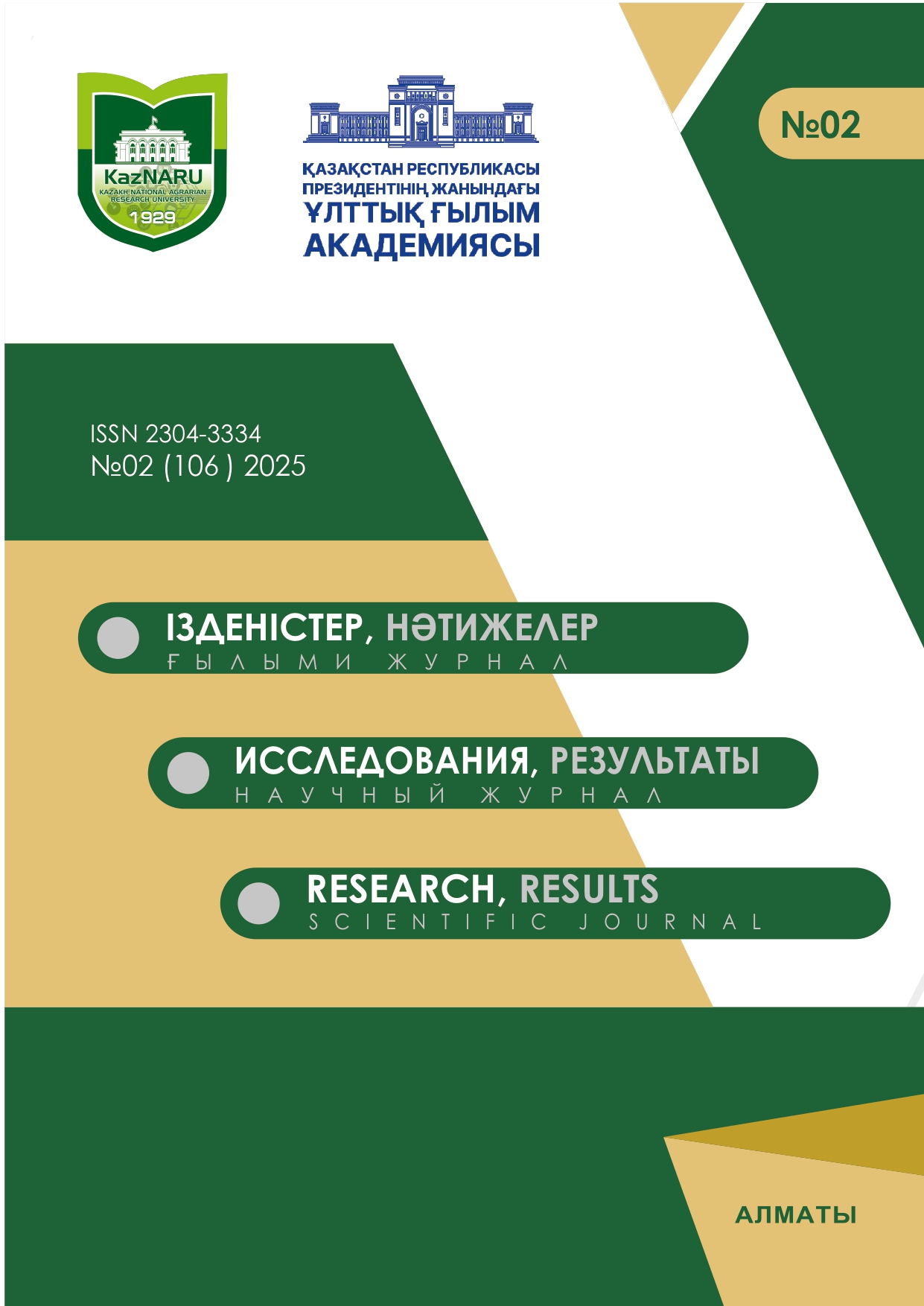ЭКОЛОГО-ЛАНДШАФТНОЕ РАЙОНИРОВАНИЕ УСТОЙЧИВОСТИ ИНФРАСТРУКТУРЫ В СЕЛЬСКОМ ХОЗЯЙСТВЕ
 https://doi.org/10.37884/2-2025/24
https://doi.org/10.37884/2-2025/24
Ключевые слова:
сельское хозяйство, инфраструктура, эколого-ландшафтное районирование, теория, принцип, исследованиеАннотация
В данной научной статье изложены основные сведения по исследованию экологического и ландшафтного деления устойчивой инфраструктуры региона в агропромышленном комплексе. В настоящее время зонирование границ ландшафтно-территориальных единиц представляет большой интерес в связи с экологизацией общества. Экологическое и ландшафтное деление территорий имеет особый характер и значение, поскольку его изучение направлено на определение точных экономических законов и расчетов регионов, а также их экологических решений и особенностей. Основная цель — определение пространственной экологической и ландшафтно-однородности территорий, а также количественная и качественная оценка взаимосвязи деятельности человека и природы в пространстве, включая использование земельных ресурсов. В связи с этим теоретические и методологические основы эколого-экономического определения территорий должны базироваться на философских, эколого-экономических представлениях о взаимосвязи окружающей среды, экологии и экономики, представляющих собой единую сложную природную эколого-экономическую систему, находящуюся в постоянном развитии. Ландшафтно-экологические землеустроительные работы отражают результаты эколого-экономической оценки земель и устанавливают качественные и количественные кадастровые характеристики земель. Содержательное районирование путем зонирования дает возможность сопоставлять различные территории участков, а также природоохранные, почвозащитно-восстановительные мероприятия или более рациональное размещение производства и расчетно определять социально-экологические свойства определенной территории, в результате чего можно определить наиболее целесообразное направление развития производства.
Работа выполнена при финансовой поддержке научно-технической программы «Формирование инфраструктуры пространственных данных Республики Казахстан с использованием технологий и принципов 2.0» (индивидуальный регистрационный номер – БР 22886730) в рамках целевого финансирования Министерства сельского хозяйства Республики Казахстан.
Библиографические ссылки
Restoration of damaged areas / P. N. Grishin, N. A. Mosienko and others. b. Saratov, MGAU publishing house, 2011. - 236 p.
Protective afforestation./ Pod ed. E. S. Pavlov. - Agropromizdat, 2012. – 263 p.
Guidelines for the design and cultivation of protective forest plantations on the lands of agricultural enterprises. M.: Kolos, 2011. - 46 p.
Guidelines for the design and cultivation of protective forest plantations on the lands of agricultural enterprises. M.: Kolos, 2011-335 p.
Forest reclamation with the basics of forestry. M.: Ear. 2012. - 333 p.
V.V. Kolpakov, i.p. Sukharev Agricultural reclamations/ Textbook for universities. - M.: Kolos, 2012 - 328 p.
Land reclamation and restoration workshop. Uch. allowance. / Sost. N.s. Yerkhov, L. P. Kozochkina, T. Orderly. - M. GUZ, 2010.
A. Cheremisinov Yu., Revenkov A. I., Burlakov S. P. Restoration of damaged areas. Fly. allowance. - M.: 2010. - 80 p.
Chernysheva A.P. Workshop on forestry and protective forestry. M.; Kolos, 2011. - 152 p.
Oldroyd DR, Grapes, RH (2008) Contributions to the history of geomorphology and Quaternary geology: an introduction:1–17
Kleman J, Borgström I, Skelton A, Hall A (2016) Landscape evolution and landform inheritance in tectonically active regions: the case of the Southwestern Peloponnese, Greece. Zeitschrift Für Geomorphologie 60:171–193
Castelltort S, Whittaker A, Vergés J (2015) Tectonics, sedimentation and surface processes: from the erosional engine to basin deposition. Earth Surface Processes and Landforms 40:1839–1846
Zhang JY, Yin A, Liu WC, Ding L, Xu XM (2016) First geomorphological and sedimentological evidence for the combined tectonic and climate control on Quaternary Yarlung river diversion in the eastern Himalaya. Lithosphere 8: 293–316
Marshall JA, Roering JJ, Gavin DG, Granger DE (2017) Late Quaternary climatic controls on erosion rates and geomorphic processes in western Oregon, USA. GSA Bulletin 129:715–731
Szabó J, Dávid L, Lóczy D (2010) Anthropogenic geomorphology: a guide to man- made landforms. Springer Science & Business Media, Netherland
Ellis EC, Fuller DQ, Kaplan JO, Lutters WG (2013) Dating the Anthropocene: towards an empirical global history of human transformation of the terrestrial biosphere. Elementa: Science of the Anthropocene 1, p.000018, doi: 10.12952/journal.elementa.000018
Tarolli P, Sofia G (2016) Human topographic signatures and derived geomorphic processes across landscapes. Geomorphology 255:140–161
Tarolli P (2016) Humans and the Earth's surface. Earth Surface Processes and Landforms 41 (15):2301-2304
Brown AG, Tooth S, Bullard JE, Thomas D, Chiverrell RC, Plater AJ, Murton J, Thorndycraft VR, Tarolli P, Rose J, Wainwright J, Downs P, Aalto R (2017) The geomorphology of the Anthropocene: emergence, status and implications. Earth Surface Processes and Landforms 42:71–90
Migoń P, Latocha A (2018) Human impact and geomorphic change through time in the Sudetes, Central Europe. Quaternary International 470:194–206
Goudie A (2018) The human impact in geomorphology – 50 years of change. Geomorphology. https://doi.org/10.1016/j.geomorph.2018.12.002
Tarolli P, Cao W, Sofia G, Evans D, Ellis EC (2019) From features to fingerprints: a general diagnostic framework for anthropogenic geomorphology. Progress in Physical Geography: Earth and Environment 43:95–128
Curebal I, Efe R, Soykan A, Sonmez S (2015) Impacts of anthropogenic factors on land degradation during the anthropocene in Turkey. J Environ Biol 36:51
Borrelli P, Robinson DA, Fleischer LR, Lugato E, Ballabio C, Alewell C, Meusburger K, Modugno S, Schütt B, Ferro V, Bagarello V, Oost KV, Montanarella L,Panagos P (2017) An assessment of the global impact of 21st century land use change on soil erosion. Nature Communications 8 (1): 2013
Tessler ZD, Vörösmarty CJ, Grossberg M, Gladkova I, Aizenman H (2016) A global empirical typology of anthropogenic drivers of environmental change in deltas. Sustainability Science 11:525–537
Wang S, Fu BJ, Piao S, Lü Y, Ciais P, Feng X, Wang Y (2016) Reduced sediment transport in the Yellow River due to anthropogenic changes. Nat Geosci 9:38
Poeppl RE, Keesstra SD, Maroulis J (2017) A conceptual connectivity framework for understanding geomorphic change in human-impacted fluvial systems. Geomorphology 277:237–250
Csima P (2010) Urban development and anthropogenic geomorphology. In: Szabó J, Dávid L, Lóczy D (eds) Anthropogenic geomorphology. Springer, Dordrecht
Sidle RC, Ziegler AD (2012) The dilemma of mountain roads. Nature Geoscience 5 (7):437-438
Penna D, Borga M, Aronica GT, Brigandì G, Tarolli P (2014) The influence of grid resolution on the prediction of natural and road-related shallow landslides. Hydrology and Earth System Sciences 18 (6):2127-2139
Ramos-Scharrón CE (2018) Land disturbance effects of roads in runoff and sediment production on dry-tropical settings. Geoderma 310:107-119
Hromyh V.V., Hromyh O.V. Cifrovye modeli rel'efa: uchebnoe posobie. – Tomsk, 2007. [in Russian]
Molzhigitova D.K., Turganaliev S.R., Usenova A.N., Izbasar Z.G., Bisengalieva L.V. Assessment of land use by small farms in fruit and vegetable growing / Journal: Izdenister, netizheler - Research, results No. 1.2021 (89) IP. 149-156.
Ospanbaev Zh., Doszhanova A.S., Abdrazakov E., Kozhageldy E. Features of the formation of productivity of legendary crops under drip irrigation. / Journal: Research, results - Research, results No. 1.2021 (89) ISSN 2304-3334. P. 283-292.
Загрузки
Опубликован
Как цитировать
Выпуск
Раздел
Лицензия
Copyright (c) 2025 Izdenister natigeler

Это произведение доступно по лицензии Creative Commons «Attribution-NonCommercial» («Атрибуция — Некоммерческое использование») 4.0 Всемирная.






